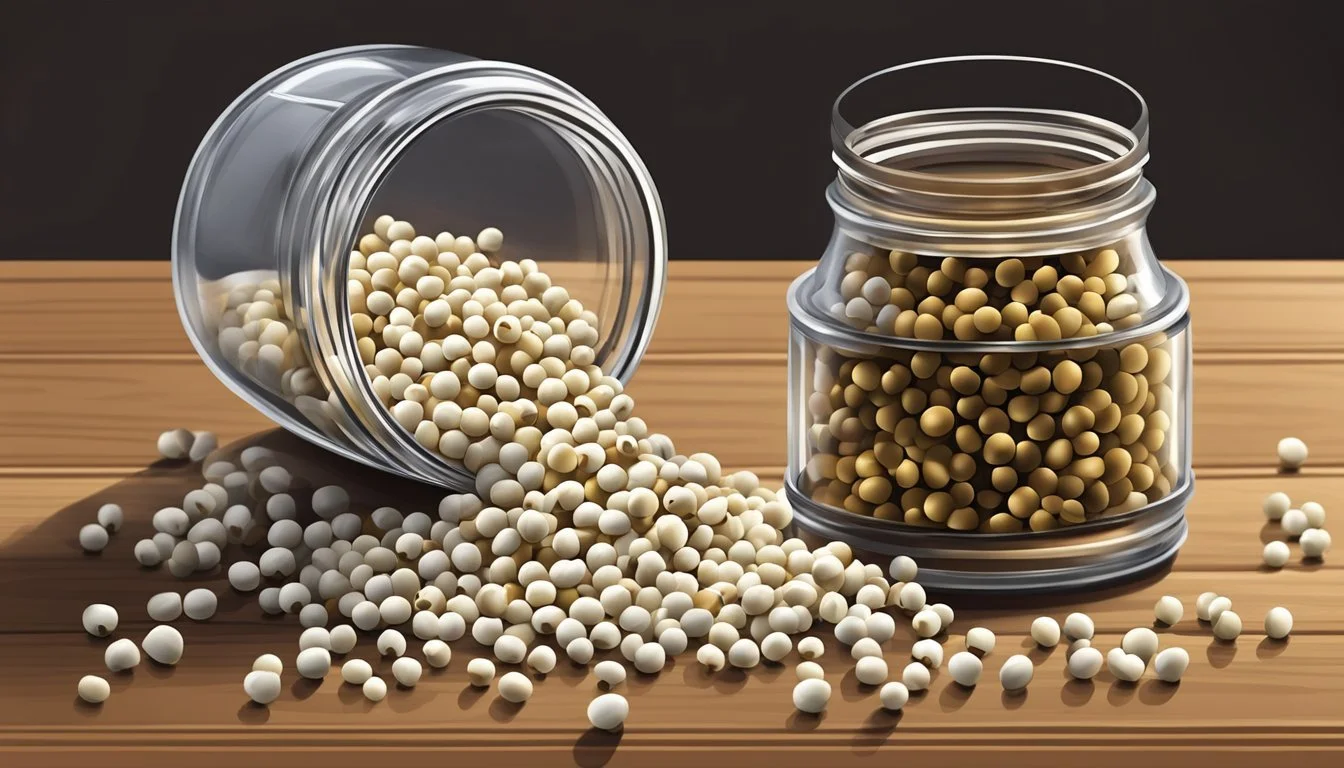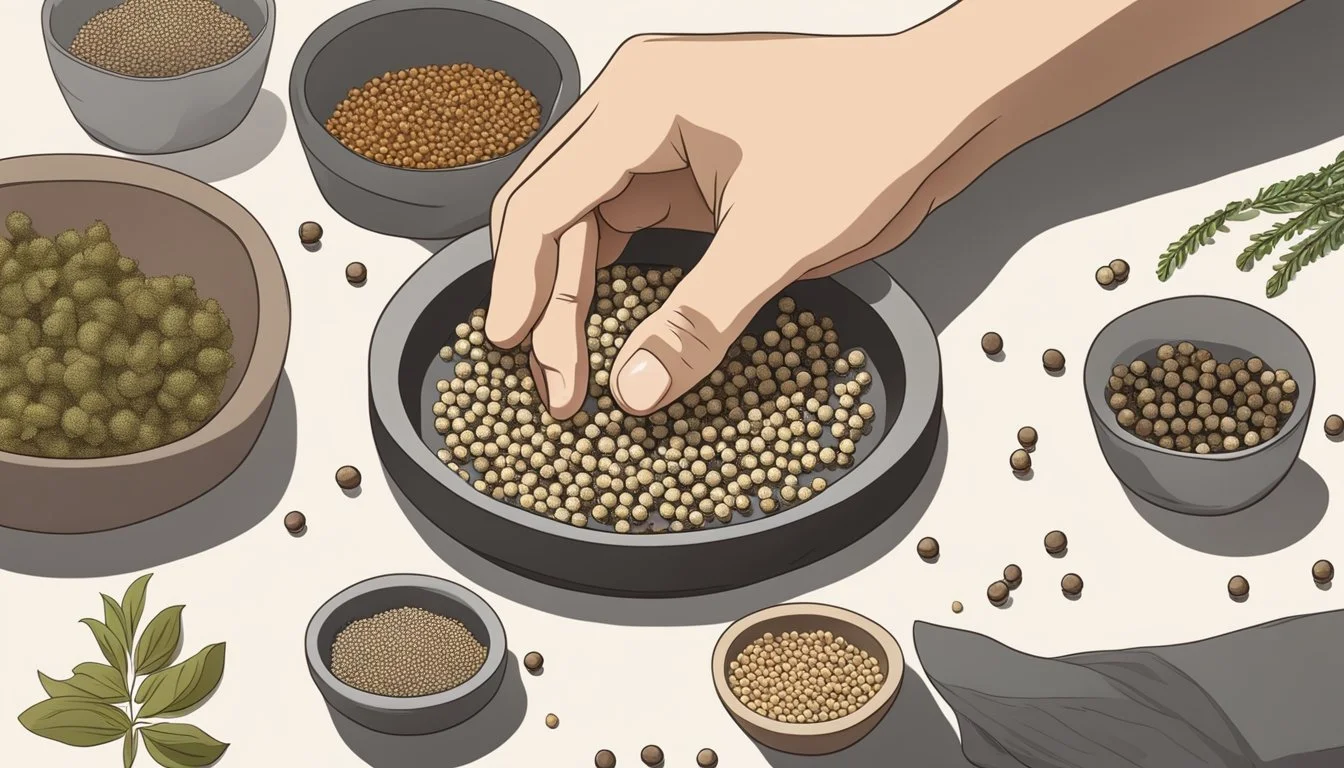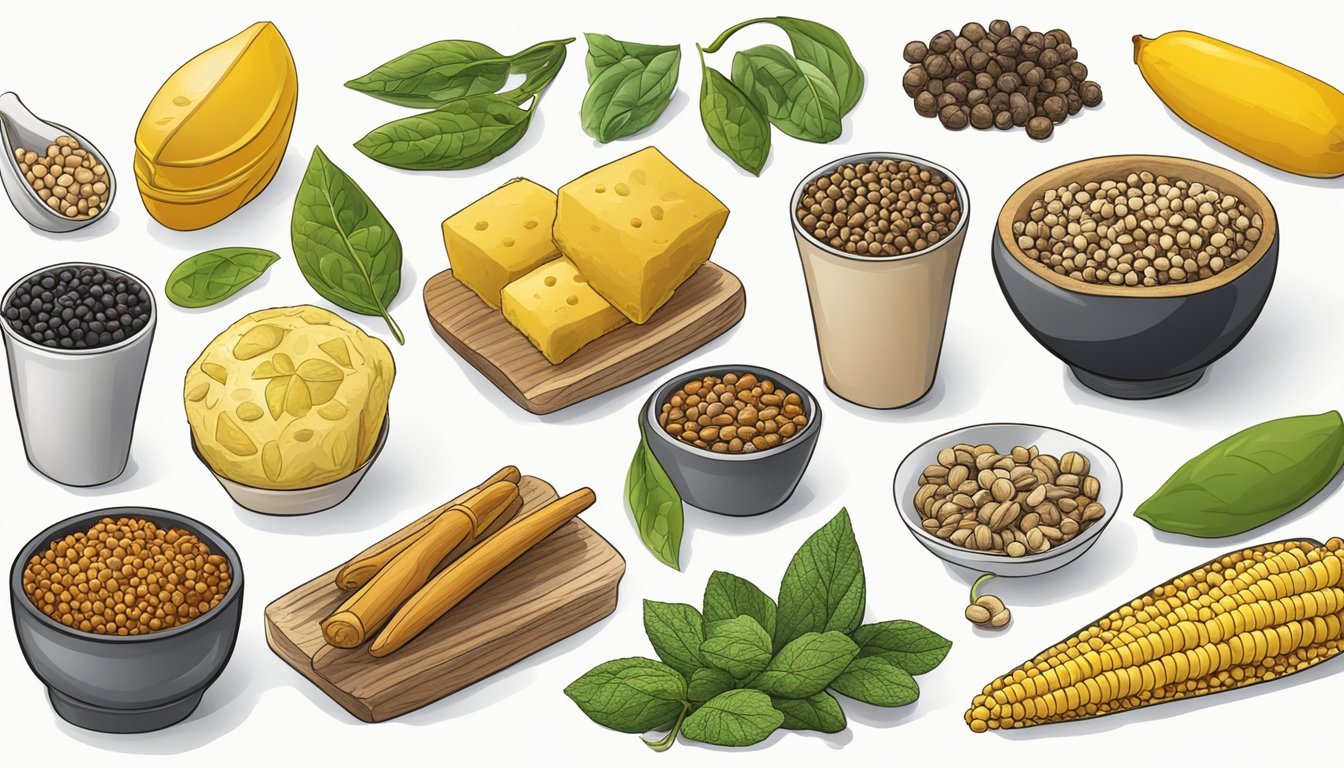White Peppercorns Substitutes
Best Alternatives for Your Cooking
Finding a substitute for white peppercorns can be easier than you think, as there are several alternatives that offer similar flavors and spice profiles. Whether you run out of this ingredient or simply prefer to experiment, you have options at your disposal.
Ground mustard, for example, may be yellow, but its mild flavor and moderate heat can work well in dishes like macaroni and cheese. Other viable options include black, pink, or green peppercorns. Each of these substitutes can be used in a 1:1 ratio with white pepper, allowing for straightforward replacements in recipes.
If you're looking for a more unique flavor, turmeric powder can not only mimic the spice of white pepper but also add a vibrant yellow hue to your dish. This is particularly ideal for those who enjoy the aromatic and rich qualities of Asian cuisine, especially in curry dishes.
Understanding White Peppercorns
White peppercorns come from the same Piper nigrum plant as black peppercorns. The difference lies in their level of maturity and processing.
White pepper is made by removing the outer layer of fully ripe peppercorns. This results in a less intense, slightly earthy flavor compared to black pepper.
These peppercorns are harvested when they reach full maturity, making them milder and less sharp. They are commonly used in dishes to maintain a pale color, avoiding the black specks that black pepper might introduce.
Key Points:
Origin: Piper nigrum plant
Maturity: Fully ripe peppercorns
Flavor: Milder and less sharp
Appearance: Light, ideal for pale dishes
Understanding these differences helps in choosing the right substitute or in knowing when to use white pepper over other types. White pepper is preferred in light-colored sauces and soups for its mild taste and subtle hint.
Common Uses of White Pepper
White pepper is a versatile spice favored for its subtleness and heat. It is regularly found in Chinese cuisine, often enhancing the flavor profile of dishes like hot and sour soup.
In Western cuisines, white pepper seamlessly blends into light-colored dishes such as béchamel and vichyssoise. Unlike black pepper, its lighter color prevents any visual interruption in these creamy, white sauces.
Another popular use is in cheese fondue. The mild yet distinct heat of white pepper perfectly complements the rich, creamy texture of melted cheese, creating a balanced flavor.
Frequently, white pepper serves as a seasoning for creamy soups and sauces. It adds a subtle layer of heat without overpowering the dish. This makes it a preferred option for nuanced, delicately flavored recipes.
Whether it’s adding a refined touch to a European sauce or a burst of flavor to an Asian soup, white pepper is a staple in many kitchens due to its adaptability and subtle heat.
Profiles of Flavor and Texture
When choosing a substitute for white pepper, understanding the flavor and texture is essential.
Cayenne Pepper
Flavor: Sharp and pungent
Texture: Fine powder
Notes: Much higher in heat, so use in smaller quantities
Green Peppercorns
Flavor: Distinctive and vibrant
Texture: Softer and slightly chewy
Notes: Ideal for light-colored dishes to avoid dark specks
Ground Mustard
Flavor: Mild with some heat
Texture: Fine powder
Notes: Adds mild spice without altering the color significantly
Ginger
Flavor: Earthy and slightly fiery
Texture: Smooth and fine
Notes: Offers a gentle heat with a unique twist
Overview of Alternatives
Substitute Flavor Texture Suitable for Light Dishes? Cayenne Pepper Sharp and pungent Fine powder No Green Peppercorns Distinctive and vibrant Slightly chewy Yes Ground Mustard Mild with some heat Fine powder Yes Ginger Earthy and slightly fiery Smooth and fine Yes
These substitutes provide a range of flavors and textures to suit different culinary needs, making them versatile in many recipes.
Substitutes for White Pepper
When you find yourself out of white pepper, several viable substitutes can step in, each adding unique flavors and characteristics to your dish. This guide focuses on five specific alternatives: ground mustard, ground ginger, ground turmeric, cayenne pepper, and ground cumin.
Ground Mustard
Ground mustard provides a mild heat similar to ground white pepper. Its slightly pungent flavor can add depth to various dishes.
It’s particularly useful in creamy sauces, macaroni and cheese, and salad dressings. Unlike white pepper, mustard powder introduces a yellow hue, which might be noticeable in light-colored dishes.
For substitution, use a one-for-one ratio. This ensures that the mild heat and tang of mustard are properly balanced within the dish.
Ground Ginger
Ground ginger brings a spicy, warm, and slightly sweet flavor to recipes.
Although distinct from white pepper, it works well in Asian dishes, soups, and marinades. Ground ginger doesn't have the same peppery heat but can add complexity.
Use it sparingly to not overpower other flavors. Start by adding half the amount specified for white pepper and adjust to taste.
Ground Turmeric
Ground turmeric is another alternative, known for its vibrant color and earthy taste.
It pairs well with vegetables, rice dishes, and curries. Turmeric's strong aroma and color are more pronounced than white pepper, so use it judiciously.
Substitute ground turmeric at a half-to-one ratio to account for these potent characteristics. Keep in mind that your dish will turn yellow.
Cayenne Pepper
Cayenne pepper provides a significant heat kick compared to white pepper.
This spicy option is suitable for dishes that can handle a fiery punch, such as stews and spicy sauces. Since cayenne is much hotter, use it cautiously.
Start with a quarter of the amount and increase as needed to avoid overwhelming the dish with heat.
Ground Cumin
Ground cumin offers an earthy, savory flavor with a hint of citrus and spice.
It's a great fit for Mexican, Indian, and Middle Eastern cuisine. While not as hot as white pepper, cumin adds warmth and depth.
Use it in a one-for-one substitution, being mindful that its distinct flavor can change the dish's profile. Adjust quantities based on personal taste preference.
Comparing White Pepper and Its Substitutes
White pepper is known for its subtle, spicy flavor and smooth texture. It’s often used in light-colored dishes for aesthetic reasons, as it blends seamlessly without adding black flakes to the food.
In contrast, black pepper and black peppercorns bring a bold, robust flavor and can be visually distinct. While black pepper can slightly alter the appearance of a dish, it provides a strong, spicy kick.
Green peppercorns are less common but serve as a viable substitute. They offer a fresher, more herbal flavor compared to white pepper. Green peppercorns are also less spicy, making them suitable for dishes requiring a milder pepper flavor.
Pink peppercorns are another alternative. They are not true peppercorns but can imitate the mild spice of white pepper. Their unique fruity undertones can add a different dimension to the dish.
Substitute Comparison Table
Substitute Main Flavor Characteristics Visual Impact White Pepper Subtle, spicy Minimal Black Pepper Bold, robust, intense Visible black flakes Green Peppercorns Fresh, herbal, less spicy Green tint Pink Peppercorns Mild spice, fruity undertones Pinkish hue
Each substitute has unique attributes that can influence both the flavor and appearance of the dish. Adjust quantities carefully to achieve the desired taste and consider the visual effects based on the dish’s requirements.
Alternatives for Specific Dishes
When choosing a substitute for white peppercorns, it's essential to consider the dish's requirements.
Creamy Soups
For creamy soups, black pepper can be used if color isn't an issue. If maintaining a white color is crucial, ground mustard or ground ginger can be used. These alternatives provide a mild heat and blend well with the soup's creamy texture.
Marinades
In marinades, black pepper or a pepper spice blend works well. They provide robust flavors that integrate nicely with meats and vegetables. For a milder approach, ground mustard can be used.
Color Profile
To maintain the color profile of light-colored dishes, such as white sauces or delicate fish recipes, opt for ground mustard or ground ginger. These alternatives ensure the dish remains visually appealing without dark specks.
Garnish
As a garnish, consider green or red peppercorns for a colorful touch. If a milder taste is preferred, garlic pepper can be a good option. It adds a subtle flavor and visually interesting flecks.
Pepper Spice Blend
A pepper spice blend can be used in various dishes to substitute white pepper. These blends often include black, white, green, and red peppercorns, providing a balanced and nuanced flavor. This option is versatile and can complement many cooking styles.
These alternatives ensure your dishes remain flavorful and visually appealing, regardless of the specific cooking need.
Visual and Color Considerations
When substituting white peppercorns, visual and color aspects are essential to ensure the dish's presentation remains unaffected. Two common alternatives, paprika and turmeric powder, each impart distinct colors and must be chosen carefully to complement or enhance the dish's appearance.
Paprika
Paprika, a ground spice made from dried red peppers, adds a vibrant red-orange color to dishes. This bright hue contrasts sharply with the pale color of white pepper.
In recipes where the visual aspect is crucial, such as white sauces or light-colored soups, paprika might not be ideal unless you aim to introduce a reddish tint.
Its color can be visually striking, making it more suitable for dishes where a red or orange coloration is desirable, like in casseroles or spicy rubs.
In addition to its color, paprika has a sweet, slightly smoky flavor, which can alter the flavor profile of the dish. Thus, its use should be deliberate, considering both the visual and flavor changes.
Turmeric Powder
Turmeric powder is known for its deep yellow color, often associated with curry powders and Indian cuisine. When replacing white pepper, it transforms the dish's appearance with its intense yellow hue.
This vibrant yellow is far from the pale color of white pepper, making it noticeable in light-colored dishes.
Its use is beneficial in recipes where a golden color is desired, such as in rice dishes, soups, and stews. However, turmeric's distinct color makes it less suitable for white or pale dishes like creamy sauces or mashed potatoes.
Additionally, the strong, earthy flavor of turmeric should be taken into account, as it will modify the taste alongside altering the visual presentation.
Heat and Spice Level Adjustments
When substituting white pepper, it's crucial to consider how the replacement affects heat and spice levels in your dish. Various peppers, like green pepper, bell pepper, and chili pepper, offer different flavors and intensities.
Green Pepper
Green pepper, or green bell pepper, provides a milder pepper flavor compared to white pepper. Unlike its hot counterparts, it adds more of a crunchy texture and a fresh, slightly bitter taste.
Use Case: Ideal for dishes that need a subtle pepper note without added heat.
Adjustment: No significant heat, so it can be used in a 1:1 ratio without affecting spiciness.
Note: It adds color to dishes, which may not always be desired.
Bell Pepper
Bell peppers, available in various colors like red, yellow, and green, offer a sweet and mild flavor. They lack the pungency and heat of white pepper.
Use Case: Suitable for recipes where sweetness can complement other flavors.
Adjustment: Replace in a 1:1 ratio for a non-spicy alternative.
Note: Different colors add visual appeal and slightly different flavors to dishes.
Chili Pepper
Chili peppers, including varieties such as cayenne and hot paprika, introduce significantly more heat than white pepper.
Use Case: Best for spicy dishes where additional heat is welcome.
Adjustment: Start with ¼ to ½ the amount of white pepper to control heat levels.
Types: Cayenne pepper, chili powder, and hot paprika offer varying levels of intensity.
Note: Adjust to taste, gradually increasing to achieve the desired spiciness.
Non-Peppercorn Alternatives
For those who need a substitute for white peppercorns but wish to avoid other types of peppercorns, consider garlic pepper and green chiles. Each offers unique tastes and can enhance a variety of dishes.
Garlic Pepper
Garlic pepper blends garlic powder with black pepper, creating a complex, savory flavor. It's a versatile seasoning suitable for dishes where you want a fragrant garlic undertone along with mild heat.
Use garlic pepper in place of white peppercorns in soups, stews, and gravies. This substitution is particularly effective in recipes that already include garlic, as it enhances the overall garlic flavor without overwhelming the dish.
When using garlic pepper, start with a 1:1 substitution ratio. Adjust based on taste preference, keeping in mind that garlic pepper adds additional flavors beyond just heat and spice. It's a practical alternative for those seeking a more layered flavor profile.
Green Chiles
Green chiles provide a fresher, more vibrant heat compared to white peppercorns. They bring both spiciness and a slight fruity note, making them ideal for Mexican, Indian, and Thai cuisines.
Fresh green chiles can be minced and added to dishes like curries, salsas, and stir-fries. In dried form, they can be ground into a powder and used sparingly—a little goes a long way due to their potent heat.
For a more subdued heat, consider using deseeded green chiles. Start with small amounts and increase as needed to avoid overpowering the dish. Green chiles are a distinctive and flavorful alternative, offering both heat and a touch of zest without the same peppercorn profile.







